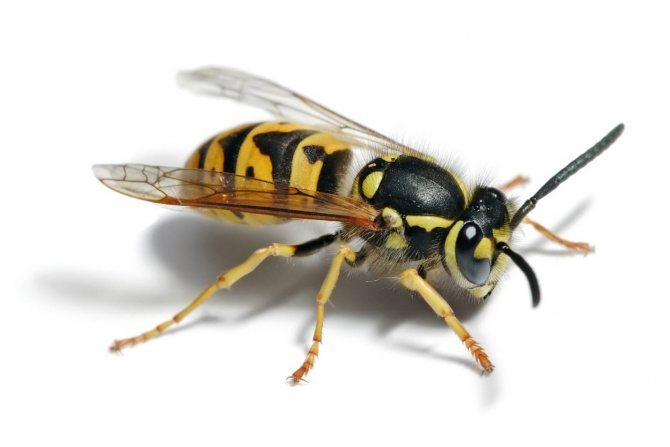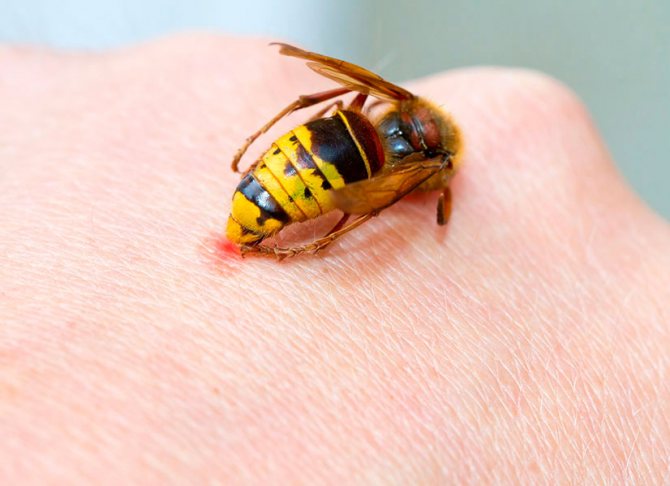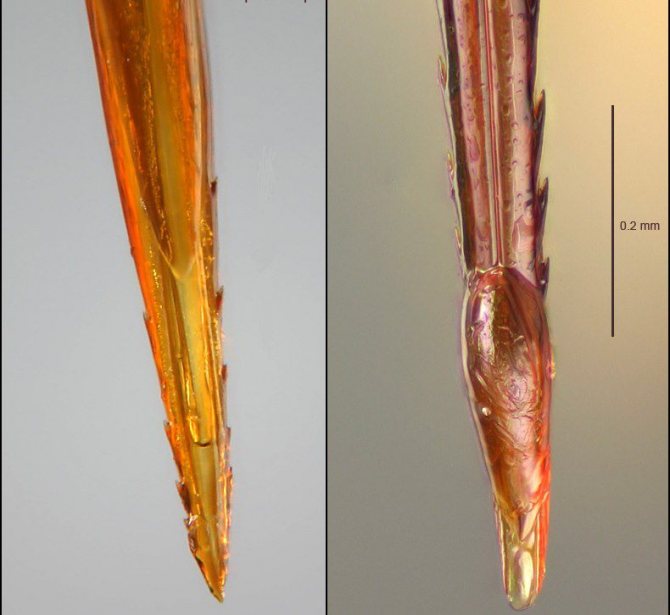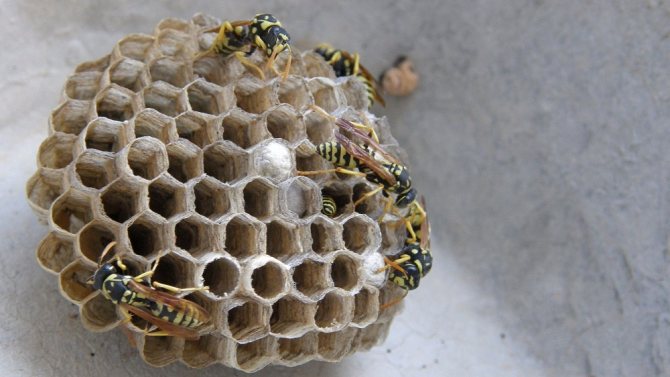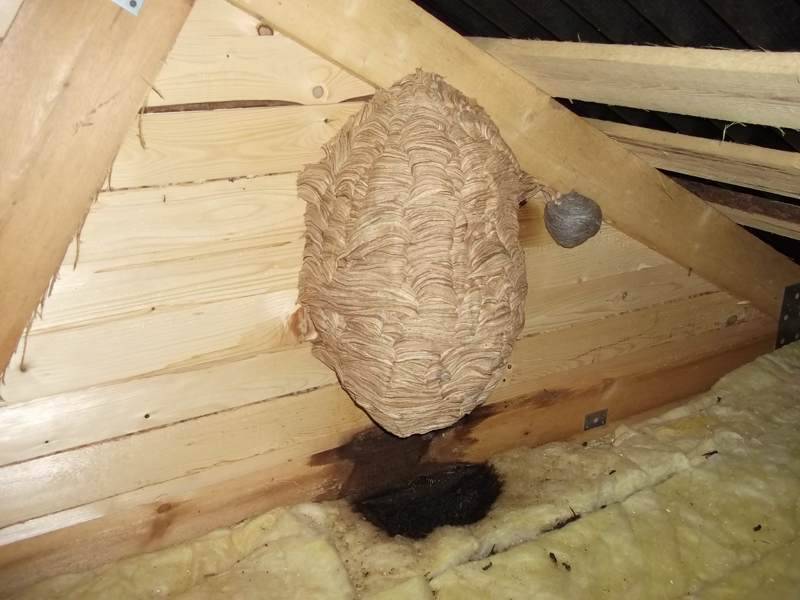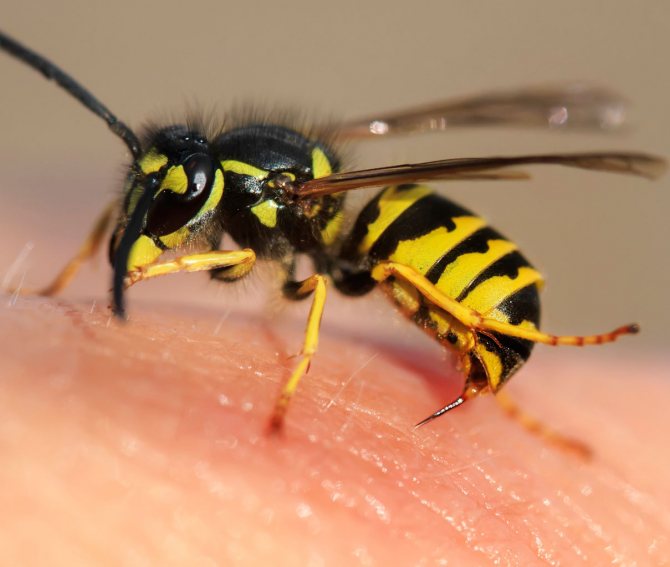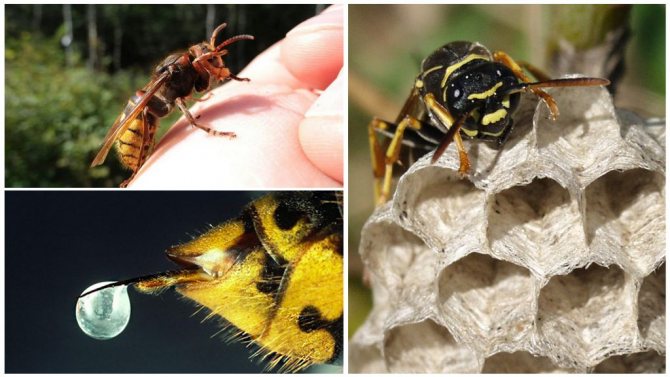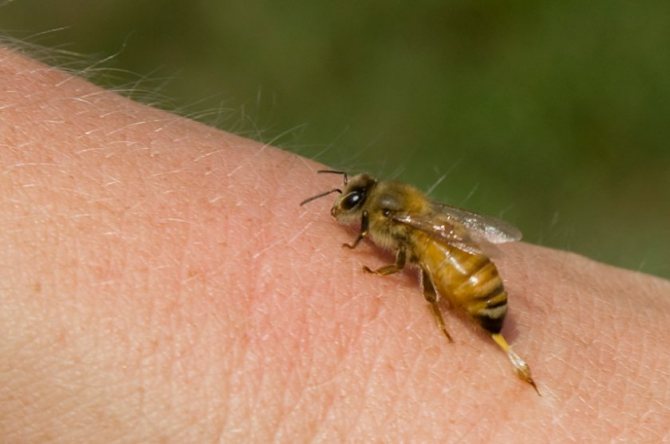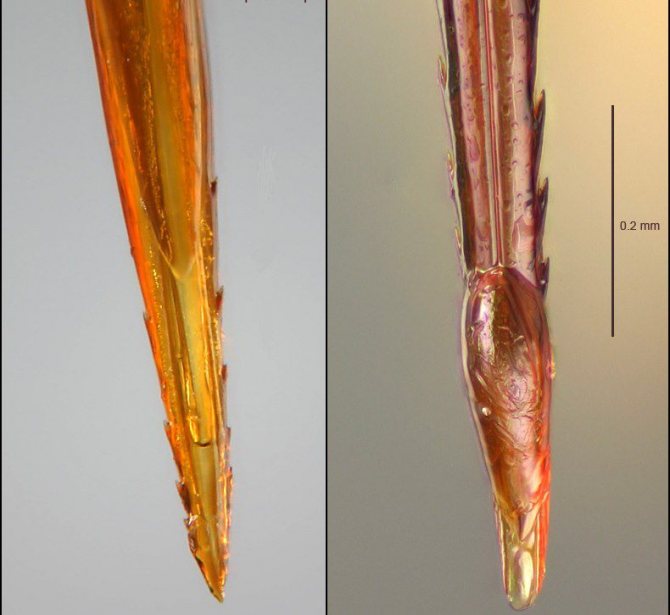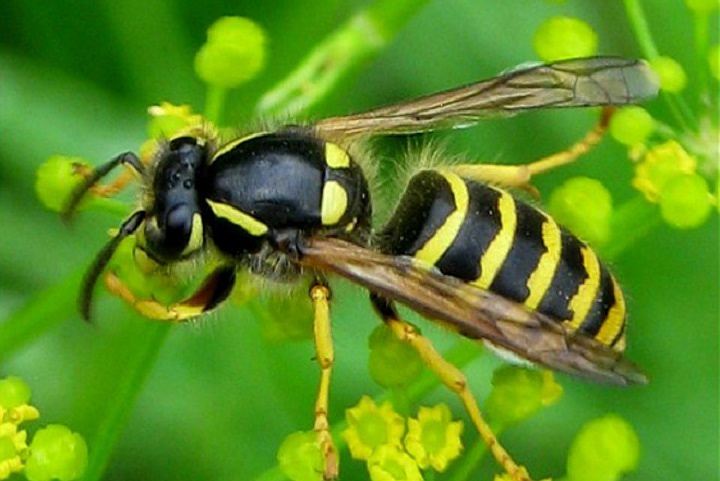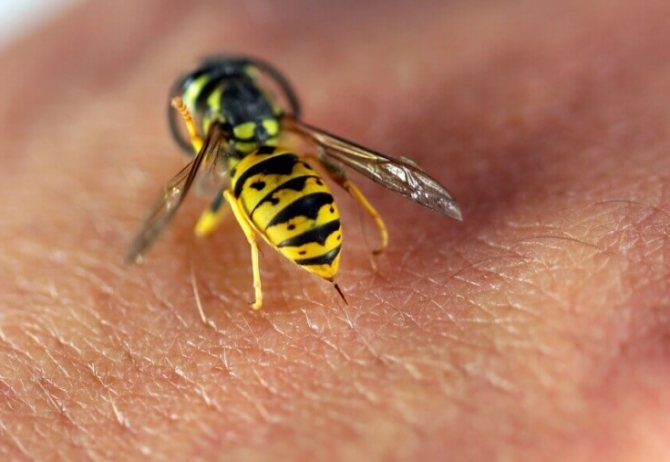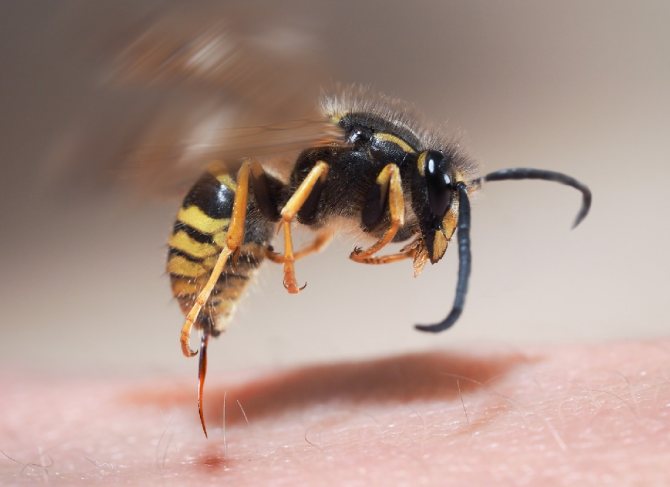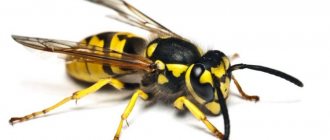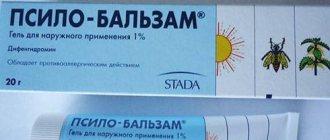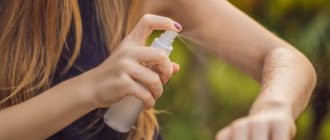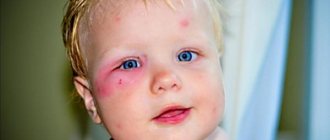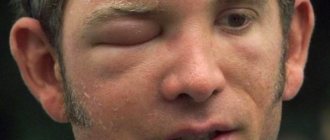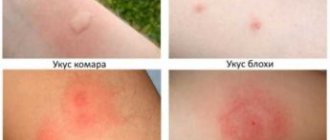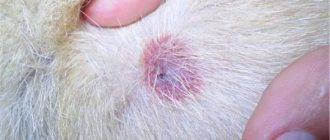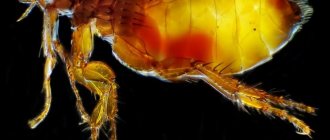There is no such person who, at least once in his life, would not be bitten by a wasp or another insect like it. And yet, despite the fact that the expression "bitten by a wasp" is the most commonly used expression, in fact this creature stings.
Does a wasp have a sting?
Almost all wasp species on the planet have a sting. It is an ovipositor modified in the course of evolution and is observed only in females. Moreover, among workers who are engaged in building a nest, collecting honey and nectar, the ovipositor is not an organ performing the function intended by nature.
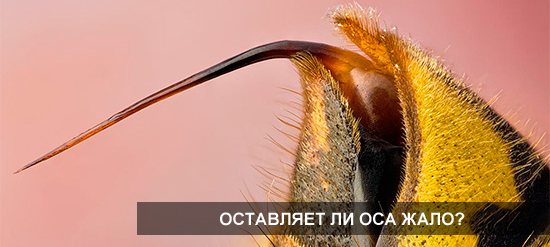
Only the uterus uses it correctly, which is guarded by all other female wasps. Their ovipositor, which has lost its purpose, has turned into a sharp and durable sting.
Important! How to eliminate the consequences of a wasp bite and how to protect yourself from contact with wasps on the street and in the house?
The sting also has its own task. Since wasps, for the most part, are predators, they use it for hunting. Striking with a sting like a blade, they inject poison into the victim's body, often large flies become it, less often grasshoppers, butterflies. Spiders are the favorite prey of wasps - they are very easy to catch. When an unsuspecting spider sits at the end of a signal thread, or even in the center of a cobweb created, the wasp punches through the delicate shell with one blow and gets its lunch.
Male wasps do not have a sting, for an understandable reason... But their color is absolutely similar to the color of armed females, therefore other animals: birds, animals, people - bypass the places of accumulation of dangerous insects, so as not to meet any of them, regardless of the peculiarities of gender differences.
Features of a sting strike
Often, those people who survived a wasp sting try to open the wound in search of a sting left in it. The coloration of bees and wasps is very similar. They belong to the same order of Hymenoptera. Perhaps that is why there was an opinion about a similar method of stinging.
When asked whether the wasp leaves a sting in the wound, there is an answer - no, it does not. This insect has the ability to strike with a sting repeatedly, each time injecting a portion of the strongest allergens under the skin of the victim or offender. Due to their high concentration, these substances cause unbearable pain by burning sensitive skin receptors. And spreading through the circulatory system, I can affect important internal organs - the heart, lungs, and the central nervous system.
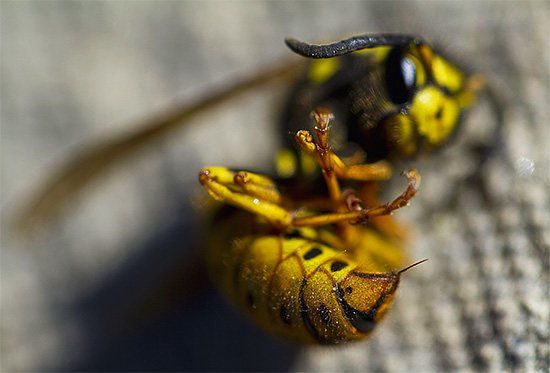

in the photo - the sting of a wasp at the time of its extension from the abdomen of an insect
The action of toxins is so rapid, and sometimes deadly for creatures with a small mass, that they are called wasp poison.
Bite or sting
Wasps, like bees, are armed with a sting, but an interesting fact is that only females have it. This weapon serves as a defense and a means of attack at the same time. The sting is an altered ovipositor, for this reason men do not have it. Since there are more females in the family, there is an opinion that wasps all have a sting.
Powerful and sharp jaws that can damage the protective layer of any insect are also a strong remedy. So the sting is not always used, and the wasps also save poison. The wasp stings one to five times, since the sting does not remain in the victim's body. And the poison must be injected completely. Age, amount of poison and species also affect the number of bites.
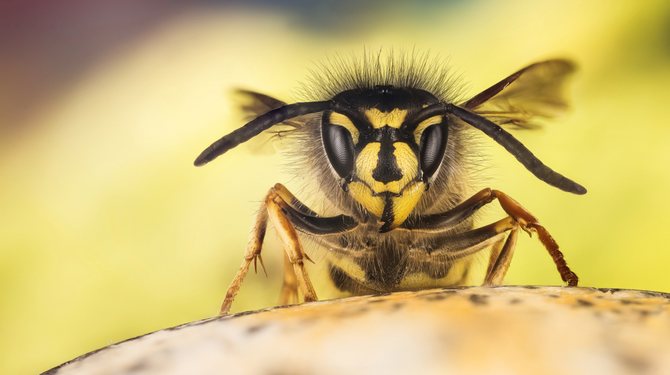

As already mentioned, wasps attack only in case of danger or the destruction of the nest.Wasps can both bite and sting, it all depends on the form of the chosen protection.
Bee sting in the neck
A bite in the neck area is characterized by pronounced swelling and inflammation of the nearby lymph nodes, as well as the appearance of pulling pains not only at the site of the bite, but also directly in the lymph nodes.
Swelling, like redness, lasts from one to ten days.
The main danger of a bite in the neck is the possibility of laryngeal edema, which can lead to respiratory arrest and death
Therefore, it is extremely important to competently provide first aid and deliver the victim to the hospital.
At home, recipes of traditional medicine will help relieve swelling.
Onion:
the bulb is cut in half and applied with a cut to the place of edema.
Collection of herbs
plantain, dandelion and parsley, which are taken in equal proportions and passed through a juicer, after which cotton swabs are soaked in the resulting juice, which are frozen, and then applied to the swollen areas of the skin.
Raw potatoes
, which should be grated, and the resulting gruel should be applied for 10 minutes to the site of the bite.
Does the sting remain
In wasps, the sting is arranged differently than that of a bee, it looks smooth, there are no notches on it, for this reason, when a wasp bites, it does not leave it in the human body.
The sting can remain in the body if it is killed during the bite, but then there are several simple ways to remove it:
- Tweezers or a needle are suitable for these purposes, only it is worth disinfecting.
- It is necessary to pull out the sting of a bee quickly, but with a wasp it is worth being patient. But you can pull it out at home.
- Carry out the procedure carefully and carefully in order to avoid a situation where the sting breaks and a particle remains in the skin, after a while it will come out on its own, but the bite site will be tightened for a long time.
Was bitten by a wasp - what to do at home
Unlike bees, after a wasp sting, you do not need to remove the sting. You need to focus on neutralizing the effects of the poison. Make sure there have been no allergic reactions. For people who are allergic to wasps, symptoms are visible immediately after the bite
It is essential to avoid anaphylactic shock, which can lead to cardiac arrest and death.
If you or your child has been stung by a wasp, immediate action should be taken to prevent the spread of the poison and relieve the pain. Place ice or a cloth soaked in cold water on the bite site. If you are using ice, wrap it in a cloth first and then place it on the sore spot. You need to keep it in place of the bite for about 30 minutes. Soak a cotton swab or paper towel in an acid solution. You can use lemon juice or vinegar for this purpose. Moisten the piece so that the liquid gets inside the hole after the insect bite
The acidic liquid neutralizes the poison and brings relief. Apply a cold cream to the area of the bite to reduce the burning sensation after applying the acidic solution. Over-the-counter antihistamines can reduce inflammation and itching after a wasp sting. Take extra care when eating or drinking. If you didn't notice that wasps were sitting on them and took them in your mouth, an irritated insect can sting you in your mouth.
In this case, suck on ice to minimize pain and swelling. A bite in the mouth can immediately cause an allergic reaction, and immediate action should be taken.
Folk recipes for a wasp bite
Lavender. It reduces the risk of infection caused by bites. It also reduces pain. One of the most effective forms is lavender essential oil. Just soak a cotton swab in the oil and apply to the bite.
Parsley. It has natural antibacterial properties that help prevent infection, relieve itching and pain.Place some parsley leaves in a mortar and pestle them with a pestle. Apply to the bite site. Keep until symptoms decrease.
Calendula. Rub the calendula flowers and apply to the bite. This will help relieve pain and itching.
Basil. Grind 1-2 basil leaves in a mortar. Apply to skin. Leave it on for a while.
Allergic reaction. If you notice any of these symptoms in a person who has suffered from a wasp sting, call an ambulance immediately, even if that person has never been allergic to insect bites.
- Labored breathing
- Swelling in the throat
- Redness of the face
- Fever
- Heart palpitations
- Dizziness, fainting, or confusion
- Upset stomach, vomiting, or diarrhea
- Swelling of the mouth, tongue, cheeks, eyes, and neck
- Rare or rapid breathing
Wasp sting structure
You can carefully examine the structure with a magnifying glass. This is a sharp, thin, smooth base in which a poison-producing gland is enclosed. After a wasp bite, the sting increases in size, launching poison into the wound.


At rest, the sting is not noticeable. It is located in the abdomen under the protective plate. The smooth structure makes it possible to easily insert the needle into the bite site and easily remove it.
As soon as the relatives of the attacker smell the poison, they will come to the aid of their comrade, and then there is no need for a casual passer-by or a purposeful citizen. After such a meeting, only an ambulance will help.
In fact, the sting is transparent, but from the side it seems dark, even black.
Bitten by a bee (wasp): first aid
Most often, bee and wasp stings do not pose a serious danger to human life. But if an insect stung a child or a person suffering from allergies, then in order to exclude serious negative consequences, it is necessary to competently provide the victim with first aid.
1. Carefully remove the sting
without squeezing it out. It is best to use tweezers for these purposes, while the bite site and the instrument itself should be pre-disinfected with any alcohol solution, in the absence of which the affected area should be rinsed with clean water. If you have been stung by a bee, then in the process of pulling out the sting, it is advisable not to damage the small bag of poison attached to the sting shaft.
2.
After removing the sting
disinfect the wound
using alcohol, iodine, brilliant green, hydrogen peroxide or ordinary soap.
3. Relieve soreness
by treating the affected area with saline, for the preparation of which you will need 1 tsp. spoon and a glass of boiled water. You can also use pain relievers and antipruritic medications.
4.
To eliminate or alleviate the manifestations of allergies, it is recommended
take any antihistamine
.
5.
Drink
a lot of liquid
, and it is desirable that it contains glucose.
6.
If allergy symptoms develop rapidly, you can use an autoinjector with
adrenaline.
7.
To prevent a drop in blood pressure, you need to drink
25 drops of cordiamine.
8.
In case of cardiac arrest or cessation of breathing, the victim is
artificial respiration
, as well as
closed heart massage
.
Important! If the condition of the victim of a bee or wasp sting worsens, then you should immediately seek qualified medical help!
How to relieve swelling if bitten by a bee
To cope with puffiness provoked by a bee or wasp sting, the usual cold compress
, because the low temperature is not only
reduces nerve endings
, but also
dulls pain receptors
, bringing slight, but still relief.
You can overcome puffiness with the help of special ointments and creams, which are abundant in pharmacies. If there is no opportunity to purchase such a tool, then you can use traditional medicine recipes.
So, you can cook soda gruel
: soda diluted with water to a mushy consistency is applied to the affected area of the skin.
Reduce swelling significantly intake of activated carbon
at the rate of 1 tablet per 10 kg of body weight.
Can be applied to the bite site alcohol compress
(the main thing is that the alcohol content does not exceed 70%). Also relieve swelling
mint or onion juice compress
... Of the folk methods, it is possible to note the application of pounded plantain, celandine or parsley to the sore spot.
Important! Often, swelling after a bee or wasp sting passes quickly. If this does not happen within two days, then you should immediately consult a doctor!
How to remove a tumor if bitten by a bee
Redness and swelling appear at the site of a bee or wasp sting instantly. This is especially dangerous if the bee was swallowed
, and the bite itself fell on the pharynx. In this case, the resulting tumor will block the airways, which will cause respiratory arrest.
Removal of the tumor will help rafinated sugar
, applied to the site of the bite and neutralizing the effect of the poison.
No less effective compresses with ice, ammonia and potassium permanganate solution
.
You can also reduce swelling by rubbing the sore spot with lemon juice or regular table vinegar (you can use sliced fresh cucumber as a cooling agent).
Difference from a bee sting
The family of bees carries out an attack only if there is anxiety or danger to the nest. If something is not pleasant, the bee strikes and the sting leaves in the human skin.
As soon as the sting of the bee penetrates the tissues, it breaks away from the insect and launches a poisonous element. Further, there is swelling, painful sensation and a periodic desire to scratch.
After the sting, it is necessary to examine the bite site and carry out first aid, since after the bite a healthy person will have a painful shock and the skin around the bite will inflame the poison.
To prevent the consequences of the sting, call an ambulance to remove the sting of the bee. Do not make sudden movements, otherwise it may break and spread the poison further, which will negatively affect the human body.
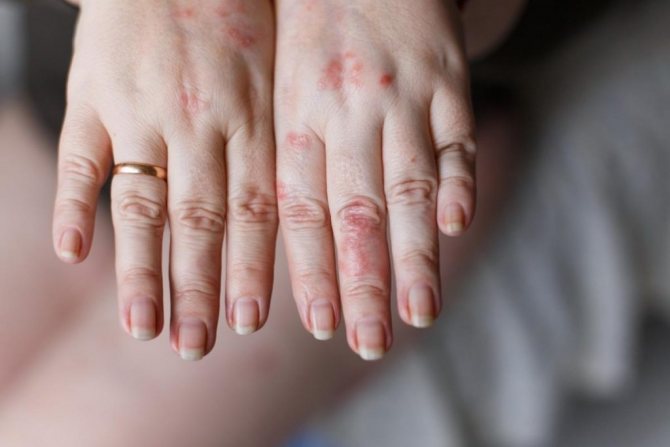

A wasp bite is dangerous because these insects are aggressive in nature. They do not need additional factors for the wasp to bite. The process happens with lightning speed and painful, then it can return to repeat the attack. What cannot, the bee will allow itself.
In addition, wasps and bees have different types of poisons, in the first case, serotonin, and in the second, acetylcholine, hence the different reaction of the body of a bitten person. But in any case, immediately after the moment of the bite, first aid is important, no matter what complicates the situation.
An allergic reaction to inhalation secreted by insects may occur. Swelling, itching, and soreness necessarily occur. When wasps and bees bite in large numbers, there will be general weakness, headaches, nausea, up to vomiting.
Well, and the most important difference between these two types, we will consider in the next section.
Poison toxicity


Regardless of the type of wasp, the structure of the sting has identical indicators, but the nature of the bite and the consequences depend on the toxicity of the poisonous secretion.
- Hornet - this is the largest wasp and it stings quite painfully. In addition, the hornet has a rather toxic poison that can seriously harm human health. The Asian hornet kills a person prone to allergies in a few minutes. Every year in countries such as Japan and China, hornet bites kill up to 50 people. The bite, in terms of the nature of the impact, is comparable to the penetration of a hot nail into the human skin. In our territories, there are no such dangerous insects, but a person can die after 5 bites of such insects, if timely assistance is not provided.
- Scoli Giant also belong to the largest wasps of the planet. It should be noted that their sting is small, and the poison is not toxic to humans.In the case of a scolia bite, a short-term numbness of the bite site is possible, and for a few minutes. Only allergy sufferers or children who still have a weak immune system can suffer from a bite of this type. These insects are not aggressive, therefore they prefer not to participate in various conflict situations, including with humans. In addition, scolias are not considered social insects and do not live in numerous families, therefore, numerous insect bites are not threatened.
- Philants belong to the most harmless creatures, representing the family of wasps. They live in the depths of the earth, in holes dug by them. These insects also have a second name - bee wolves, since adults are capable of destroying bee colonies, since bees form the basis of their diet. The larva eats 5 bees to become an adult. As a rule, bee wolves attack their prey on the fly, plunging a sting into it, which leads to paralysis of the insect. After that, they eat their prey or carry them to their nest. Philanthropists live in the earth, while finding their nest without any problems at any distance.
- Pompilids - these are wasps with a long sting and potent venom. Therefore, the bites of these wasps are quite painful. These insects are quite aggressive and attack at the slightest sign of aggression towards them. More than 150 species live on our territory. Adults grow up to 3 cm in length and lead an isolated lifestyle, not creating nests and numerous families. Eggs are laid on spiders. After birth, the larva eats the spider from the inside. The sting of these aggressive insects is quite powerful and strong.
It is very important to know what to do if the wasp has bitten. This is especially true in relation to those people in whom the body reacts very violently to the action of insect venom, causing severe consequences, and sometimes fatal.
Is the wasp dying
The bee stings and dies, since during the detachment of the sting, the gland with poison and the digestive tract are damaged, which leads to death.
The wasp stings a person and, with the help of muscles, pulls him back and flies away, even if it happens so that she will lose her weapon, this will not affect her life in any way, the only thing is that she can only defend herself with the help of her jaws.


Wasps have amazing features, due to the fact that they have thin waists, they are able to fold in half and deliver striking blows. A huge number of species from large to small representatives have their own venom and can harm human health from a few seconds to one minute.
On a note, you need to know that hot weather warms them up for an aggressive reaction. Here is such a dangerous and insidious species of insects, but let's make a reservation that they will not attack for no reason, not when.
How to avoid a wasp bite
To avoid a wasp bite, follow the rules
Unpleasant painful sensations from a wasp bite in some cases pose a direct threat to life. Consider the rules of behavior that will reduce the risk of a wasp sting:
Places where wasps accumulate should be avoided. Seeing a wasp, you should not make noise and wave your hands, thereby attracting its attention. After a trip to nature, going to the market for fruit, baskets, packages, bags should be carefully examined for insects there. Do not use strong-smelling perfumes, as wasps are attracted to fragrances. A person dressed in bright colors is also at risk due to the fact that wasps can mistake him for a flowering plant. Fruits, sugary drinks are a source of attraction for insects, therefore, before sending them into your mouth, you must carefully examine for the presence of wasps. In nature, you often want to take off your shoes and walk barefoot on the grass
This should be done carefully, as there may be hornets' nests on the ground, and there is a possibility of stepping on and being stung.A person in loose clothing that does not fit to the body runs the risk of being bitten, as wasps can fly under the shirt. Wasps love empty bottles and cans of soda water and beer. Therefore, it is undesirable to leave them with you after drinking drinks .. Wasp stings are quite common in the summer months, so everyone needs to know how to avoid it, and if that's all still failed to do it, then knowledge about the consequences of a bite and first aid will be useful
Competent sequential actions will help to avoid threats to the health and life of the victim
A wasp sting is a fairly common occurrence in the summer months, so every person needs to know how to avoid it, and if this still could not be done, then knowledge about the consequences of a bite and first aid will come in handy. Competent sequential actions will help to avoid threats to the health and life of the victim.
It will be useful to watch a video in which the doctor will tell you how to provide assistance and what to do if you are bitten by a wasp.
Wasps are evil, but not insidious
We must pay tribute to these winged insects. They try to prevent possible inclinations in their direction with the help of their bright black and yellow striped coloring, as if saying “don’t touch me, it will be bad”. But not all people have sharp eyesight, and attentiveness often leaves much to be desired. He came too close, stretched out his hand too sharply - and felt the sting of a wasp "on his skin". Photos of characteristic reddened blisters-swellings are adorned with various medical guides and memos for vacationers in those regions where there is a danger of being bitten. It is better, of course, to get acquainted with the consequences of wasp attacks from pictures, but few people can boast that they have not experienced this burning pain at least once in their life.
The blow of the wasp sting is strong, it is able to pierce the dense chitinous shell of the shell of most insects, which are hunted by these cruel predators.
How to distinguish insects
If you are far from entomology, but care about the preservation of beneficial bees, then it is enough to know the most striking visual differences. In flight, these signs cannot be caught, but in a calm state they are striking:
- Coloring. The differences are significant. Insects are striped, but the intensity of color, their contrast in the wasp is more pronounced. It will differ in more elegant colors. Bright, sunny yellow stripes interspersed with black. Bees are more modest. Their yellow is calm, muted, the transition is less contrasting. Some representatives of the families have a white or brown color in the arsenal.
- Villi. Bees focus on pollination. Therefore, they are covered with a well-distinguishable fluff - special villi for carrying pollen. You cannot suspect the wasp of such hard work: the abdomen is bare, even glossy.
- Wasps are elongated. They can even be called graceful. Bees are more rounded and denser.


If you look very biasedly, you will definitely see lumps of pollen in bees on legs.
They also differ in their habitat. If you find a nest, then the wax comb points directly to the bees. Wasps build them from clay, plant debris, wood.
Allergy sufferers
The totality of organic toxins contained in what the wasp stings is so rich in harmful constituents that it poses a danger to almost all people who are allergic to at least something. It's just some kind of universal poison. People who have an unpleasant feature of the body to react painfully to the ingress of certain chemical compounds into it know what pharmaceutical preparations help them get rid of debilitating attacks. Of the standard medicines, you can recommend Fenistil ointment or Diazolin tablets.If, despite the use of these funds, it is still bad and the painful sensations intensify, you should immediately seek medical help at the nearest medical institution.
How dangerous is it
Disagreeable, but generally not dangerous. However, there are some special situations in which it can cause severe discomfort or even lead to the death of a person. The insect has little poison, however, despite its modest size, it is no less than the huge, scary and shaggy bird-eating spider injects into its victim when bitten. By itself, the portion of toxins is small. But she can kill a person too. How?
The wasp stings where danger finds it. A person feels that something is crawling along the back of his head or shoulder - and clap his palm on this place! The wasp dies, but heroically strikes retaliation. If the bite did not hit some important blood vessel, then this is good (although it is still bad and painful).
Appearance
This insect looks like a giant among its own kind, the length of the wasp can reach up to 10 centimeters. Due to the fact that it is very large, the opinion about them was frightening. But, despite its impressive size, it is completely non-aggressive if not disturbed.
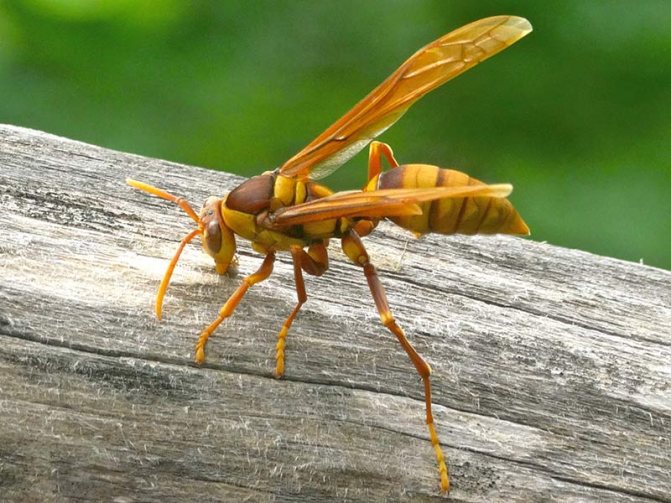

The colors can be either brown or yellow. Its body is equipped with four wings. The abdomen is shaped like a barrel. The eyes located on the sides of the head are very complex in structure and allow the insect to completely control everything that is nearby. The antennae serve as olfactory and tactile receptors capable of recognizing the slightest vibrations in the air. They are also used in construction as a measuring instrument. With them, the executioner checks the size of the cells in the nest.
The jaws of the executioner's wasp are so strong that they can easily bite through the shells of beetles and praying mantises. They are smart, and even able to distinguish their relatives by their external data.
Her little body is also interesting. No wonder there is the concept of a wasp waist. The narrow transition between the abdomen and the chest makes it easier for her to fold in order to sting harder. The sting is located on the abdomen, and is the ovipositor. Through it, the wasp secretes poison. This insect is capable of delivering a double blow, as it uses not only a sting, but also powerful jaws.
What are the reactions of a person to wasp poison
In order not to get confused after an unexpected bite of a wasp, you need to know what the possible reactions of the human body to poison are.
Of course, each organism is unique, but the following options can be distinguished:
- the first reaction is redness at the site of the bite, the rapid onset of swelling and severe itching;
- possible hemorrhage from the bite site if small blood vessels were damaged by insects;
- an allergic reaction, since wasp poison is the strongest allergen.
Therefore, allergy sufferers should always have an antiallergic drug with them. It is better to choose a substance in an ampoule - this way the medication begins to act faster. In addition, in nature, you must be very careful not to come close to the wasp nest or to swat the approaching insect.
The healing time of a wound from a bite is different for each person. It all depends on the individual tolerance of wasp poison. But everyone heals painfully and not quickly. The tumor subsides on average in 3-5 days. Complete healing of the wound takes one and a half to two weeks. Do not let the healing process take its course. It is necessary to lubricate the wound with special healing agents.
There are three types of intoxication of the human body with wasp poison:
- Local character - at the time of the bite, there is a sharp pain, burning sensation, swelling of the damaged area, an allergic reaction.
- Toxic in nature - a severe headache appears and the body temperature rises. Sometimes vomiting and even convulsions are possible.
- Allergic nature - manifests itself instantly and proceeds in an acute form. At first, the victim feels a tingling sensation in the tongue, face, head, hands and feet.Then there is an itching or burning sensation of the whole body. The person feels weak and his limbs go numb. Ears and face gradually swell. Nausea and vomiting are possible. The most difficult consequence is anaphylactic shock with loss of consciousness.
With the third type, it is necessary to urgently call an ambulance. The second type, depending on the reaction, can be with or without a doctor's call. For the first type, it is enough to use our advice. It is very important to know the levels of intoxication of the body. Such information is important when deciding on the need to call an ambulance, as well as a competent explanation of the situation that has arisen.
Deadly danger
But the worst thing happens if a person carelessly does not look at grapes, peaches, apricots or other summer sweetness before trying it. Wasps also love fruits and often sit on them. You need to be extremely careful, take the fruit in your hands, examine it from all sides. Otherwise ...
The wasp, of course, can sting on the lip, then the whole face will swell. But if it happens in the mouth or even deeper, the situation will become critical. The swelling will block the windpipe and suffocate the person. Not everyone knows how to do a tracheotomy, and without it, it is unlikely that it will be possible to save the victim. So people, be careful! Look at what you eat in the fresh air and at home, especially in summer.
There is another factor that makes wasp bites deadly. These insects live in families, work together and are very close-knit. If an enemy appears or a situation arises that they may consider threatening, a counterattack on a dangerous (or seemingly such) object will be swift, decisive and merciless. The rebuff is accompanied by the mobilization of all forces, including possible reserves. In this case, the goal is to inflict maximum damage on the aggressor, real or imaginary. The person who is the victim of a group attack may not understand what caused such anger. And the reason is simple: he simply approached a distance that seems dangerous to the inhabitants of the nest (clay or made of a material resembling thick paper). Anyone can get into such a situation, therefore, after hearing the threatening buzz of a wasp swarm, try to immediately leave the danger zone. If an adult is stung by twenty or more individuals, then he receives a life-threatening dose of poison. The child is at risk with fewer bites.
Why is a wasp sting dangerous for humans?
The bite of a wasp itself is not deadly, the reaction of the human body to it and the substances that entered the skin is dangerous. If there is no aggravated reaction (allergy), then the symptoms and consequences will begin to disappear a couple of days after first aid is provided.


If a wasp has bitten in the eye, nose or lip, it is fraught with severe swelling of the entire face. If a wasp stung near the eye, panophthalmitis may develop later, i.e. inflammation of the mucous membranes of the eyeball. A bite on the lips, tongue, or neck can cause breathing difficulties and even blocking oxygen.
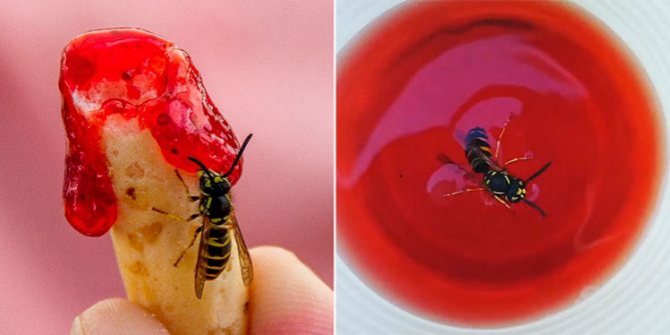

For pregnant women, a wasp sting is especially dangerous, because a pronounced allergic reaction can harm the fetus, and most special medicines are not allowed.
For a child, a bite is no more dangerous than for an adult and, in addition to allergies, it can lead to severe fright and hysteria.
Outcome
A wasp sting is anatomically different from a bee sting. Only females have such a formidable weapon. When bitten by a wasp, they do not leave a sting in the victim's body. An exception is possible only when the insect is swatted at the time of the bite. It is imperative to remove a foreign body from the victim's wound and provide him with assistance.
In case of complication or the second type of reaction, you should consult a doctor. If, after the defeat, the third type of reaction occurs, then an ambulance must be called immediately, otherwise, it may be fatal.

